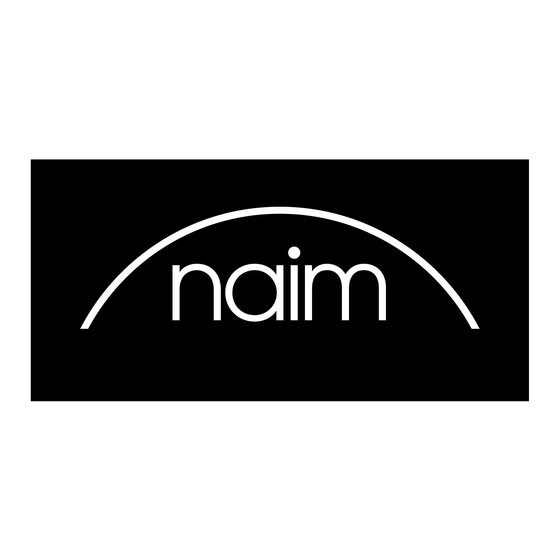
Advertisement
Quick Links
The Naim Hard Disk Player and Music Server Database
Abstract
Music Servers have traditionally stored music in
association with a database to allow retrieval of music at
an Album level. While this is in accordance with the
great majority of commercially available databases it is
certainly not the manner in which a normal user selects
music from conventional storage.
Music Servers, therefore, generally fall far short of the
requirements of serious listeners of Classical Music,
Jazz, and Compilation albums.
A better solution had to be developed before Music
Servers and Hard Disk players attain ubiquity in the
market alongside conventional sources such as CD
players.
This paper demonstrates how information at Track level
with Naim Extended Metadata can give a user
experience beyond the convenience of conventionally
selecting a CD from the shelf. Powerful database
processing and search mechanisms deliver an intuitive
user interface for both the casual user as well as the
dedicated musicologist, whether playing music from the
Hard Disc or simply playing a CD album in real-time.
1.
Background
Traditionally, physical vinyl record and CD collections
have been stored on shelves with spines visible. The
content of the spines reflects the marketing endeavours
of the record company on the one hand and also serves
to indicate contents of the single disc or album for
selection by the user.
Selection of an album quickly
offers additional information as soon as the album is
removed from the shelf, as track information is readily
visible along with other information relating to artists and
the specific recording.
In order for a Music Server or Hard Disk Player to match
or surpass the convenience of selecting discs from a
collection on a shelf, a database internal to the Server
has to be constructed to match the ripped disc.
The only unique identification for the disc relates to the
properties of the data on the disc: number of tracks,
track lengths, total play time etc. Information contained
on the CD sleeve is not known to the Server.
The combination of tracks, track times etc. is possibly
unique, but not always guaranteed to be so. At the time
of ripping the Server will interrogate one or several on-
line databases in order to match the disc being ripped
with a managed and maintained database. The relevant
database entry is downloaded, and together with Cover
www.naimaudio.com
Alan Ainslie
Naim Audio
Southampton Road, Salisbury, SP1 2LN, England
alan.ainslie@naimnet.com
- 1 -
Art is used to give the user a local database within which
music can be selected for play.
2.
Current Situation
The shortcomings of the current state of the art of
cataloguing ripped CDs fall into several categories.
Virtual music collections where the data representing the
music is stored, but where there is no physical carrier
create a new problem for cataloguing.
industry responded with several commercial databases
offering cataloguing at an ALBUM level:
ARTIST (SINGLE ARTIST FOR THE ALBUM)
ALBUM
GENRE
And within the selected album simply:
SONG
will identify any individual track.
This is the situation, supported additionally with Cover
Art that has been used by the various free or subscribed
databases for a number of years.
ALBUM LEVEL
Searchable
Artist
Y
Album
Y
Genre
Y
Cover Art
While this situation will work for simple Albums where
the Album title is unambiguous and the Artist is the same
for all tracks, the system immediately fails for
compilations, where there are many possible artists
individual to each track in the album.
Virtually all Classical music is assembled onto an album
as a compilation, and therefore it is implicit that the
current situation fails with classical music.
2.1 International releases may be different
Albums may well exist in several versions in different
territories. These may have a different track makeup or
different Cover Art, even the same tracks but in different
order, or differing track
refinements in later releases.
2.2 Gapless playback
Albums may be designed for continuous play.
concept of 'tracks' being merely to identify location on
the physical disc. E.g. Opera, or Pink Floyd: The Wall.
Initially the
TRACK LEVEL
Searchable
Song
Y
lengths due to editing
The
th
24
April 2008
Advertisement

Subscribe to Our Youtube Channel
Summary of Contents for NAIM MUSIC SERVER DATABASE
- Page 1 The Naim Hard Disk Player and Music Server Database Alan Ainslie Naim Audio Southampton Road, Salisbury, SP1 2LN, England alan.ainslie@naimnet.com Abstract Art is used to give the user a local database within which Music Servers have traditionally stored music in music can be selected for play.
- Page 2 Albums may contain material additional to playable music – data tracks etc. The basic engine for the Naim Hard Disc Player and Music Servers is provided by Digital Fidelity and is 2.5 Metadata isn’t always correct based around a powerful XML database application.
- Page 3 The rationale is that the end user will not be constrained by the physical CD boundaries of the original disc, which are purely an artifice introduced by the Record Company. The Naim user is therefore free of the constraints of the physical CD when searching. user...
- Page 4 However, there is in place a mechanism to optimise the database for regional variations. Should a Naim Server receive a less than perfect match from AMG, the secondary lookup of an alternative database is used. This will certainly not have the depth of track level metadata, but will at least provide basic disc identification.
- Page 5 11. Conclusion Naim have addressed the major shortcomings of Music Servers so far offered to the market, and in so doing have created a totally new concept in convenient playback of archived digital music. Searching for material is often quicker than finding the...

Need help?
Do you have a question about the MUSIC SERVER DATABASE and is the answer not in the manual?
Questions and answers